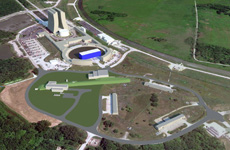Fermilab's Muon Department at edge of Intensity Frontier
 |
|
Rendering of the proposed Fermilab Muon Campus, which will support the experiments Muon g-2 and Mu2e. Image courtesy of Muon Department/FESS |
Fermilab's antiproton source is preparing to host a new tenant—the Muon Department.
The Muon Department was established to support and develop the infrastructure for Muon g-2, Mu2e and future muon experiments as part of Fermilab's move to the Intensity Frontier.
"We're very excited to start something new again," said Jerry Annala, head of the Muon Department. "We're still in the early stages, but we are moving ahead with two exciting projects and are working with the experimenters to transition into muon research."
As part of the Intensity Frontier initiative, Fermilab is inaugurating experiments that hunt for physical anomalies and look for discrepancies between the Standard Model's predictions and experimental measurements. Scientists working on Muon g-2 and Mu2e have chosen to scrutinize muons, one specimen of the subatomic world.
"Muons are special," said Chris Polly, the Muon g-2 project manager. "They are light enough to be produced copiously, yet heavy enough that we can use them experimentally to uniquely probe the accuracy of the Standard Model."
The Muon g-2 experimenters will examine the precession, or wobble, of muons that are subjected to a magnetic field. The main goal is to test the Standard Model's predictions of this value by measuring the precession rate experimentally. If there is an inconsistency, it could mean the Standard Model is incomplete or wrong.
"An analogous experiment at Brookhaven National Laboratory showed that there is a discrepancy between the predicted value and the experimentally observed value," Polly said. "They measured the precession with 3 sigma certainty, which made the discrepancy tantalizing, but not decisive. We want to take this experiment to the next level and make an extremely precise measurement that will either verify or refute the Standard Model. If the discrepancy remains it could be interpreted as evidence of an undiscovered class of particles interacting with muons or that the muons themselves are more complicated than we previously thought."
The Mu2e experiment will also use an intense beam of muons but will examine a property outside the understanding of the Standard Model: the possibility of a muon-to-electron conversion.
Read more
—Sarah Charley
|